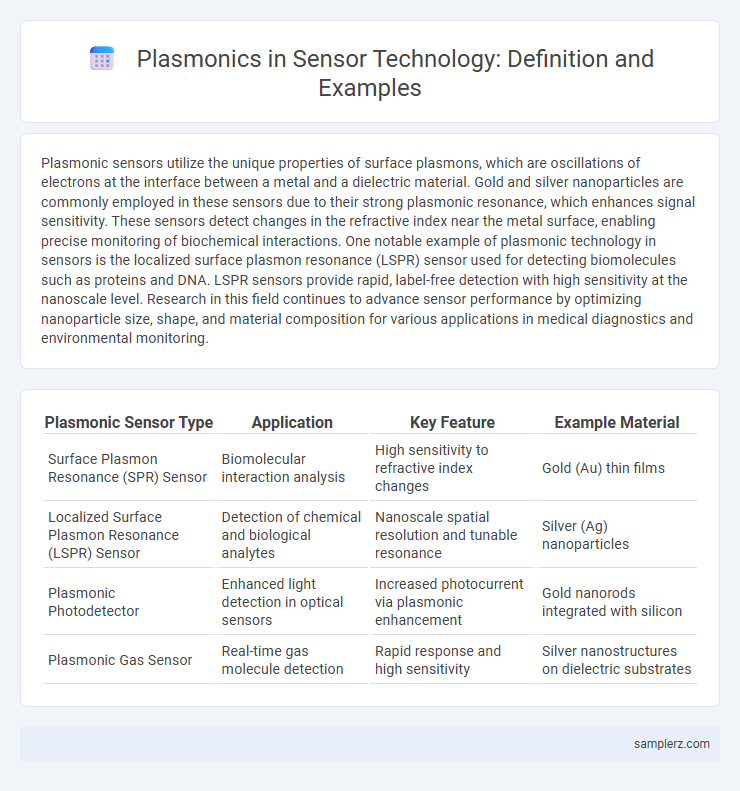Plasmonic sensors utilize the unique properties of surface plasmons, which are oscillations of electrons at the interface between a metal and a dielectric material. Gold and silver nanoparticles are commonly employed in these sensors due to their strong plasmonic resonance, which enhances signal sensitivity. These sensors detect changes in the refractive index near the metal surface, enabling precise monitoring of biochemical interactions. One notable example of plasmonic technology in sensors is the localized surface plasmon resonance (LSPR) sensor used for detecting biomolecules such as proteins and DNA. LSPR sensors provide rapid, label-free detection with high sensitivity at the nanoscale level. Research in this field continues to advance sensor performance by optimizing nanoparticle size, shape, and material composition for various applications in medical diagnostics and environmental monitoring.
Table of Comparison
| Plasmonic Sensor Type | Application | Key Feature | Example Material |
|---|---|---|---|
| Surface Plasmon Resonance (SPR) Sensor | Biomolecular interaction analysis | High sensitivity to refractive index changes | Gold (Au) thin films |
| Localized Surface Plasmon Resonance (LSPR) Sensor | Detection of chemical and biological analytes | Nanoscale spatial resolution and tunable resonance | Silver (Ag) nanoparticles |
| Plasmonic Photodetector | Enhanced light detection in optical sensors | Increased photocurrent via plasmonic enhancement | Gold nanorods integrated with silicon |
| Plasmonic Gas Sensor | Real-time gas molecule detection | Rapid response and high sensitivity | Silver nanostructures on dielectric substrates |
Introduction to Plasmonics in Sensing Technologies
Plasmonics in sensing technologies exploits surface plasmon resonances to achieve high sensitivity in detecting molecular interactions at the nanoscale. Metal nanostructures, such as gold and silver nanoparticles, serve as plasmonic sensors by enhancing electromagnetic fields and enabling real-time monitoring of chemical and biological changes. This approach significantly improves detection limits in applications like medical diagnostics, environmental monitoring, and chemical analysis.
Principle of Plasmonic Sensors
Plasmonic sensors operate on the principle of surface plasmon resonance (SPR), where free electrons on a metal surface resonate with incident light at specific wavelengths, generating enhanced electromagnetic fields. Changes in the local refractive index near the metal surface--caused by analyte binding--shift the resonance condition, enabling sensitive detection of chemical or biological substances. Gold and silver nanostructures are commonly used materials due to their strong plasmonic properties, which improve sensor sensitivity and specificity.
Surface Plasmon Resonance (SPR) Sensors: Applications and Examples
Surface Plasmon Resonance (SPR) sensors leverage the resonant oscillation of conduction electrons at the interface between a metal and a dielectric to detect molecular interactions with high sensitivity. These sensors are extensively applied in real-time biomolecular analysis, such as antigen-antibody binding studies and monitoring drug-target interactions without the need for labeling. Industries including medical diagnostics, environmental monitoring, and food safety rely on SPR sensors for rapid, accurate, and label-free detection of chemical and biological substances.
Localized Surface Plasmon Resonance (LSPR) Sensors
Localized Surface Plasmon Resonance (LSPR) sensors utilize the oscillation of conduction electrons in metallic nanoparticles to detect molecular interactions with high sensitivity. These sensors are applied in biosensing for real-time detection of biomolecules, detecting changes in refractive index induced by target analytes at the nanoparticle surface. Advances in LSPR sensor design improve detection limits and enable label-free, rapid sensing in medical diagnostics and environmental monitoring.
Plasmonic Nanoparticles in Biosensing
Plasmonic nanoparticles, such as gold and silver, enhance biosensing by amplifying local electromagnetic fields, leading to increased sensitivity in detecting biomolecules like proteins and DNA. Their unique surface plasmon resonance properties enable label-free, real-time analysis with high specificity and low detection limits. Integration of plasmonic nanoparticles in sensors improves diagnostic accuracy in medical, environmental, and food safety applications.
Plasmon-Enhanced Photodetectors
Plasmon-enhanced photodetectors leverage localized surface plasmon resonances to amplify light-matter interactions, significantly improving sensitivity and detection speed. Integrating metallic nanostructures such as gold or silver nanoparticles with semiconductor materials enables efficient photon absorption and charge carrier generation in the visible to near-infrared spectrum. These advancements in plasmonic sensor technology facilitate high-performance applications in optical communication, environmental monitoring, and biomedical diagnostics.
Plasmonic Sensors for Environmental Monitoring
Plasmonic sensors leverage the unique optical properties of surface plasmons to detect chemical and biological contaminants with high sensitivity in environmental monitoring. These sensors enable real-time detection of pollutants such as heavy metals, pesticides, and toxic gases by measuring changes in refractive index or fluorescence signals. Advances in nanostructured plasmonic materials, including gold and silver nanoparticles, enhance detection limits and selectivity for diverse environmental applications.
Plasmonic Sensors in Medical Diagnostics
Plasmonic sensors utilize surface plasmon resonance (SPR) to achieve ultra-sensitive detection of biomolecules, enabling real-time monitoring of medical conditions at the molecular level. These sensors enhance the detection accuracy of proteins, DNA, and glucose, significantly improving early diagnosis of diseases such as cancer and diabetes. Integration with lab-on-a-chip devices facilitates point-of-care testing, advancing personalized medicine through rapid and non-invasive diagnostic techniques.
Future Trends in Plasmonic Sensor Technology
Future trends in plasmonic sensor technology emphasize enhanced sensitivity through the integration of nanostructured materials like graphene and gold nanoparticles, enabling ultra-low detection limits for biomolecules and chemical agents. Emerging applications leverage quantum plasmonics to boost signal-to-noise ratios, facilitating real-time, label-free detection in medical diagnostics and environmental monitoring. Innovations in flexible and wearable plasmonic sensors promise continuous health tracking and portable chemical analysis, driving smart device adoption across healthcare and security sectors.
Challenges and Opportunities in Plasmonic-Based Sensors
Plasmonic-based sensors face challenges such as limited sensitivity due to signal damping and difficulties in fabricating uniform nanostructures at scale. Opportunities lie in enhancing detection limits by integrating advanced materials like graphene and optimizing nanostructure designs for stronger localized surface plasmon resonance (LSPR). Exploiting multiplexed sensing capabilities and real-time monitoring can significantly advance applications in biomedical diagnostics and environmental monitoring.

example of plasmonic in sensor Infographic
 samplerz.com
samplerz.com